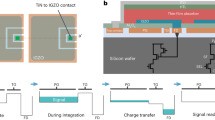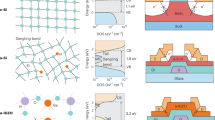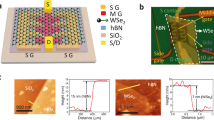Abstract
The composition of amorphous oxide semiconductors, which are well known for their optical transparency1,2,3,4, can be tailored to enhance their absorption and induce photoconductivity for irradiation with green, and shorter wavelength light. In principle, amorphous oxide semiconductor-based thin-film photoconductors could hence be applied as photosensors. However, their photoconductivity persists for hours after illumination has been removed5,6, which severely degrades the response time and the frame rate of oxide-based sensor arrays. We have solved the problem of persistent photoconductivity (PPC) by developing a gated amorphous oxide semiconductor photo thin-film transistor (photo-TFT) that can provide direct control over the position of the Fermi level in the active layer. Applying a short-duration (10 ns) voltage pulse to these devices induces electron accumulation and accelerates their recombination with ionized oxygen vacancy sites, which are thought to cause PPC. We have integrated these photo-TFTs in a transparent active-matrix photosensor array that can be operated at high frame rates and that has potential applications in contact-free interactive displays.
This is a preview of subscription content, access via your institution
Access options
Subscribe to this journal
Receive 12 print issues and online access
$259.00 per year
only $21.58 per issue
Buy this article
- Purchase on Springer Link
- Instant access to full article PDF
Prices may be subject to local taxes which are calculated during checkout




Similar content being viewed by others
Change history
16 February 2015
In the version of this Letter originally published, Khashayar Ghaffarzadeh, with affiliation at the London Centre for Nanotechnology, University College London, London WC1H 0AH, UK, had been omitted from the list of authors. Following internal and external investigations, this has now been corrected in the online versions of the Letter. Sanghun Jeon, Seung-Eon Ahn, Ihun Song, Chang Jung Kim, U-In Chung, Inkyung Yoo and Kinam Kim disagree with this correction.
References
Nomura, K. et al. Room-temperature fabrication of transparent flexible thin-film transistors using amorphous oxide semiconductors. Nature 432, 488–492 (2004).
Fortunato, E., Pereira, L. & Barquinha, P. Oxide semiconductors: Order within the order. Phil. Mag. 89, 2741–2758 (2009).
Robertson, J. Disorder, band offsets and dopability of transparent conducting oxides. Thin Solid Films 516, 1419–1425 (2008).
Hoffman, R. L., Norris, B. J. & Wager, J. F. ZnO-based transparent thin-film transistors. Appl. Phys. Lett. 82, 733–735 (2003).
Lany, S. & Zunger, A. Anion vacancies as a source of persistent photoconductivity in II–VI and chalcopyrite semiconductors. Phys. Rev. B 72, 035215 (2005).
Jiang, H. X. & Lin, J. Y. Percolation transition of persistent photoconductivity in II–VI mixed crystals. Phys. Rev. Lett. 64, 2547–2550 (1990).
Nomura, K. et al. Thin film transistor fabricated in single-crystalline transparent oxide semiconductor. Science 23, 1269–1272 (2003).
Park, J. C. et al. Highly stable transparent amorphous oxide semiconductor thin film transistors having double stacked active layers. Adv. Mater. 22, 5512–5516 (2010).
Jeon, S. et al. Nanometer-scale oxide thin film transistor with potential for high density image sensor applications. ACS Appl. Mater. Int. 3, 1–6 (2011).
Lee, M-J. et al. Low temperature-grown transition metal oxide based storage materials and oxide transistors for high density non-volatile memory. Adv. Funct. Mater. 18, 1587–1593 (2008).
Hosono, H. Ionic amorphous oxide semiconductors: Material design, carrier transport, and device application. J. Non-Cryst. Solids 352, 851–858 (2006).
Park, K. et al. Transparent and photo-stable ZnO thin film transistors to drive an active matrix organic-light-emitting diode display panel. Adv. Mater. 21, 678–682 (2009).
Liu, P-T., Chou, Y-T. & Teng, L-F. Charge pumping method for photosensor application by using amorphous indium–zinc oxide thin film transistors. Appl. Phys. Lett. 94, 242101 (2009).
Janotti, A. & Van de Walle, C. G. Native point defects in ZnO. Phys. Rev. B 76, 165202 (2007).
Oba, F., Togo, A., Tanaka, I., Paier, J. & Kresse, G. Defect energetics in ZnO: A hybrid Hartree–Fock density functional study. Phys. Rev. B 77, 245202 (2008).
Feng, P. et al. Giant persistent photoconductivity in rough silicon nanomembranes. Nano Lett. 9, 3453–3459 (2009).
Su, Y. K. et al. Ultraviolet ZnO nanorod photosensors. Langmuir 26, 603–606 (2010).
Suehiro, J. et al. Dielectrophoretic fabrication and characterization of a ZnO nanowire-based UV photosensor. Nanotechnology 17, 2567–2573 (2006).
Ryu, B., Noh, H-K., Choi, E-A. & Chang, K. J. O-vacancy as the origin of negative bias illumination stress instability in amorphous In–Ga–Zn–O thin film transistors. Appl. Phys. Lett. 97, 022108 (2010).
Ghaffarzadeh, K. et al. Persistent photoconductivity in Hf–In–Zn–O thin film transistor. Appl. Phys. Lett. 97, 143510 (2010).
Gorrn, P., Lehnhardt, M., Riedl, T. & Kowalsky, W. The influence of visible light on transparent zinc tin oxide thin film transistors. Appl. Phys. Lett. 91, 193504 (2007).
Kamada, Y. et al. Reduction of photo-leakage current in ZnO thin film transistors with dual gate structure. IEEE Electron Devices Lett. 32, 509–511 (2011).
Jin, Y., Wang, J., Sun, B., Blakeseley, B. C. & Greenham, N. C. Solution-processed ultraviolet photodetectors based on colloidal ZnO nanoparticles. Nano Lett. 8, 1649–1653 (2008).
Soci, C. et al. ZnO nanowire UV photodetectors with high internal gain. Nano Lett. 7, 1003–1009 (2007).
Li, L. et al. Electrical transport and high performance photoconductivity in individual ZrS2 nanobelts. Adv. Mater. 22, 4151–4156 (2010).
Xia, F., Mueller, T., Lin, Y-M., Valdes-Garcia, A. & Avouris, P. Ultrafast graphene photodetector. Nature Nanotechnol. 4, 839–843 (2009).
Kamiya, T., Nomura, K., Hirano, M. & Hosono, H. Electronic structure of oxygen deficient amorphous oxide semiconductor a-InGaZnO: Optical analyses and first-principle calculations. Phys. Status Solidi C 5, 3098–3100 (2008).
Nomura, K. et al. Subgap states in transparent amorphous oxide semiconductor, In–Ga–Zn–O, observed by bulk sensitive X-ray photoelectron spectroscopy. Appl. Phys. Lett. 92, 202117 (2008).
Prades, J. et al. The effect of electron–hole separation on the photoconductivity of individual metal oxide nanowires. Nanotechnology 18, 465501 (2008).
Janotti, A. & Van de Walle, C. G. Oxygen vacancies in ZnO. Appl. Phys. Lett. 87, 122102 (2005).
Kuo, Y. Thin Film Transistors: Materials and Processes Vol. 1 (Kluwer Academic, 2003).
Acknowledgements
The authors are grateful to SAIT colleagues Y. K. Cha, K. J. Park and C. Y. Moon for assistance with the experiments, and S. Heo and J. Lee for X-ray photoelectron spectroscopy analysis.
Author information
Authors and Affiliations
Contributions
S.J., S-E.A. and I.S. designed this work. S.J. and A.N. prepared the manuscript. S.J., S-E.A. and I.S. carried out the experiment and electrical analysis. E-h.L. performed transmission electron microscopy analysis. S.L. worked on drawing the energy band diagram and deriving the equations. A.N. and J.R. contributed to analysis and interpretation of results relevant to persistent photoconductivity and photoconductive gain. All authors discussed the results and implications and commented on the manuscript at all stages.
Corresponding authors
Ethics declarations
Competing interests
The authors declare no competing financial interests.
Supplementary information
Supplementary Information
Supplementary Information (PDF 1437 kb)
Rights and permissions
About this article
Cite this article
Jeon, S., Ahn, SE., Song, I. et al. Gated three-terminal device architecture to eliminate persistent photoconductivity in oxide semiconductor photosensor arrays. Nature Mater 11, 301–305 (2012). https://doi.org/10.1038/nmat3256
Received:
Accepted:
Published:
Issue Date:
DOI: https://doi.org/10.1038/nmat3256
This article is cited by
-
Miniaturized spectrometer with intrinsic long-term image memory
Nature Communications (2024)
-
Integration of microbattery with thin-film electronics for constructing an integrated transparent microsystem based on InGaZnO
Nature Communications (2023)
-
All solution-processed SnO2/1D-CsAg2I3 heterojunction for high-sensitivity self-powered visible-blind UV photodetector
Science China Materials (2023)
-
Visible-light stimulated synaptic plasticity in amorphous indium-gallium-zinc oxide enabled by monocrystalline double perovskite for high-performance neuromorphic applications
Nano Research (2023)
-
MoS2/PEDOT:PSS nanocomposite films for deep UV sensing: role of the radiation-induced trapping and localization of charges
Applied Physics A (2023)



